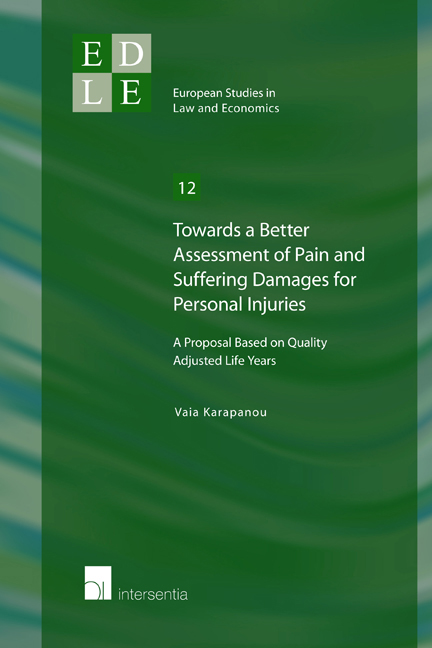 Towards a Better Assessment of Pain and Suffering Damages for Personal Injuries
Towards a Better Assessment of Pain and Suffering Damages for Personal Injuries Published online by Cambridge University Press: 22 November 2017
The assessment of pain and suffering damages as it is currently performed in many countries does not seem to take into account all the crucial elements that would allow the objectives of tort law and of the economic analysis of tort law to be attained. The preceding analysis clearly demonstrated that there is a large scope for improvement, which could be achieved by utilizing a measure that has been used so far to evaluate health treatments and medical interventions.
The proposed QALY approach can take into consideration elements that are important for the attainment of compensation and satisfaction, such as the intensity of the pain, the type, severity and duration of the injury, the loss of life expectancy, and the personal characteristics of the victim, and express them in the resulting awards in a predictable and consistent manner. Moreover, the QALY can offer the missing framework to estimate the ex ante determined damages; it can set the damages so as to ensure that the injurer correctly internalizes the costs the victim would be willing to pay and that the victim is not over-insured against her will. By treating immaterial losses arising from personal injuries in a way that is consistent with both deterrence and insurance considerations, the suggested framework can therefore strike a balance between the two goals with respect to the treatment of immaterial losses. Besides the abovementioned advantages of the QALY, chapter 5 also explained that the proposed approach is expected to result in a decrease in litigation costs and to facilitate speedier adjudication, consequently enhancing the overall reliability of the judicial system. Finally, chapter 6 examined whether, under certain conditions, the QALY framework could be able to address the possibility that victims (and judges) disregard the gradual improvement in life satisfaction after an adverse event due to hedonic adaptation and focusing illusion and thus claim for (or decide in favor of) a higher damage award than what would correspond to the actual losses incurred. If additional empirical evidence were indeed to corroborate that these misperceptions occur regularly, and at the same time legal scholarship were to reach the conclusion that they should be accounted for in the assessment of pain and suffering damages, then the proposed QALY framework could perform this task.
To save this book to your Kindle, first ensure [email protected] is added to your Approved Personal Document E-mail List under your Personal Document Settings on the Manage Your Content and Devices page of your Amazon account. Then enter the ‘name’ part of your Kindle email address below. Find out more about saving to your Kindle.
Note you can select to save to either the @free.kindle.com or @kindle.com variations. ‘@free.kindle.com’ emails are free but can only be saved to your device when it is connected to wi-fi. ‘@kindle.com’ emails can be delivered even when you are not connected to wi-fi, but note that service fees apply.
Find out more about the Kindle Personal Document Service.
To save content items to your account, please confirm that you agree to abide by our usage policies. If this is the first time you use this feature, you will be asked to authorise Cambridge Core to connect with your account. Find out more about saving content to Dropbox.
To save content items to your account, please confirm that you agree to abide by our usage policies. If this is the first time you use this feature, you will be asked to authorise Cambridge Core to connect with your account. Find out more about saving content to Google Drive.